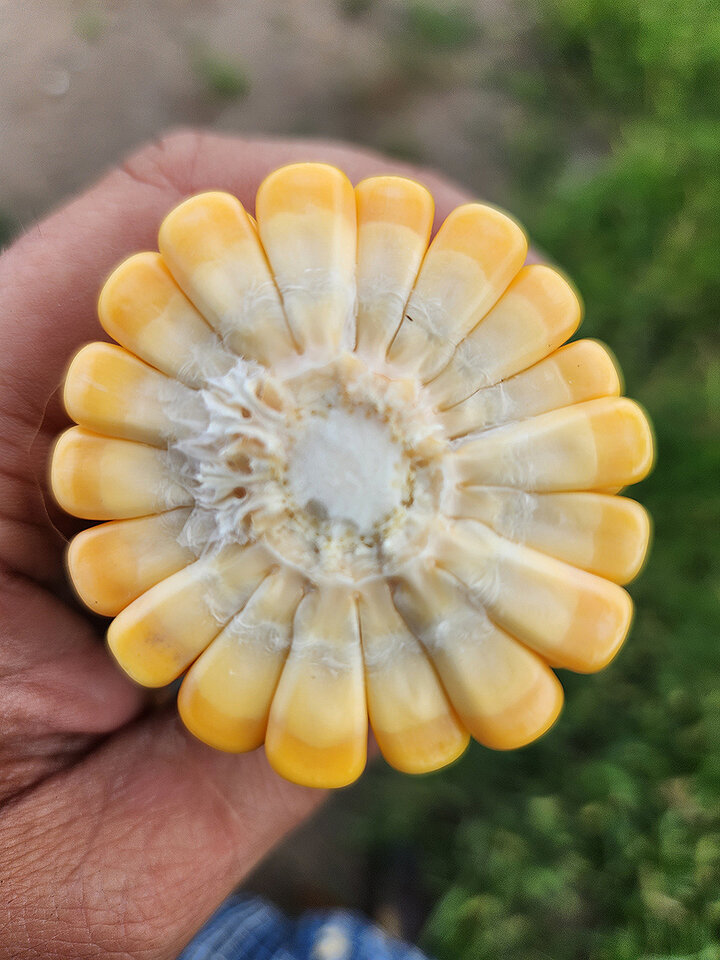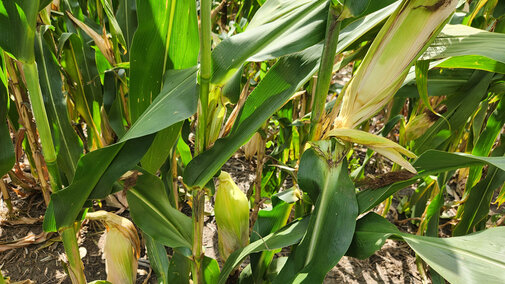Across Nebraska, when scouting you may start to see more ears that have prematurely drooped. In corn, ears typically remain upright until after they have reached black layer (R6). Once corn reaches physiological maturity, the shank that supports the ear begins to deteriorate causing the ear to droop. However, many of our acres currently range in development from dough (R4) to dent (R5), with some fields just entering black layer (R6).
What is causing this phenomenon in our corn? And what does this mean for yield in those fields affected?


Conditions That Favor Early Ear Decline
There can be several contributing factors that cause early drooping of ears: drought stress, high temperatures, poor root development, population, and genetics can all be players. Note that if you are raising non Bt trait corn, then insect pressure from European corn borer could also be a possible factor for early ear droop on your acres. Root development and function could also play a role especially under drought conditions. One can also dig plants with droopy ears and examine root development to determine if compaction layers, etc. played a role in water uptake. Another thing Jenny has noticed on some plants with droopy ears is a darkened area of Fusarium crown rot in the lower crown area when splitting open plants that are dug.
This has been another interesting year weather-wise in Nebraska with the eastern portion of the state experiencing greater drought-stress than the western portion. We experienced early August rains followed by a lack of moisture thereafter. High temperatures with the lower humidity experienced in the afternoons can further reduce corn grain filling by increasing evapotranspiration, putting more stress on the corn plant. This was quite evident the past week with temperatures in the 90’s-100's causing plants to shut down. The past week of extreme heat coupled with moisture stress was too much for some plants to overcome. Even plants in irrigated fields are seen drooping after this week's heat and the inability for plants to keep up with the water demand. Thus, we feel drought stress coupled with the high heat are the biggest causes of ears dropping we're experiencing this year. The shank can become weakened due to a loss of turgidity in combination with carbohydrates being cannibalized under drought stress. Once the shank bends over, the pinch point restricts the flow of carbohydrates from the plant to the ear. If the flow is completely shut off, grain fill to the ear ceases and the kernels will prematurely reach black layer.
Determining Impact on Yield
Timing and scouting will be key to understanding the impact early ear droop will have on yield. Scouting your fields to determine the development stage of the ear when it droops is critical. It is important to note that at the beginning of dent corn still has about 30 to 33 days until it reaches full maturity. Kernel moisture is at 60% and kernel dry matter is only 45% of the final at the beginning of dent (Nielsen, 2019).
When looking at estimated loss, if the ear droops during early dent when the milk line is hard to differentiate, yield loss could be up to 40% if the flow of carbohydrates is completely shut off (Carter and Hesterman, 1990). If the ear droops at the end of the dent stage, when the milk line is close to the tip of the kernel, then yield losses could be up to 12% (Carter and Hesterman, 1990). To estimate these losses in your field, identify the development stage in which the ear drooped then you can multiply the percentage of ears affected by the estimated yield loss per ear (depending on the growth stage utilizing the 40% or 12% loss estimations).
Another factor with ears that prematurely drooped is the integrity of the shank. If the shank is weakened, there is an increased risk of the ear dropping to the ground and increasing harvest losses. This can be exaggerated with less than ideal weather conditions such as high wind events. Ultimately, pre-harvest scouting can help set expectations come harvest time and help to prioritize fields for harvest.
References
Carter, P.R. and O.B. Hesterman. 1990. Handling Corn Damaged by Autumn Frost (NCH-57). Purdue Extension. https://www.extension.purdue.edu/extmedia/NCH/NCH-57.html. (Accessed 8/31/2020).
Nielsen, RL (Bob). 2019. Grain Fill Stages in Corn. Corny News Network, Purdue University. http://www.agry.purdue.edu/ext/corn/news/timeless/GrainFill.html. (Accessed 8/31/2020).

